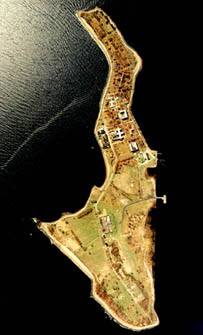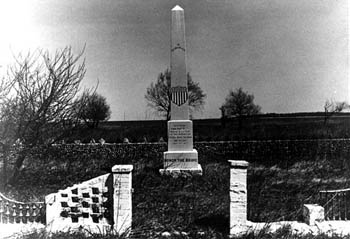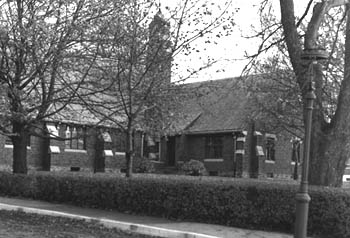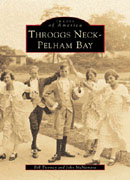| Hart Island -- Part 1: Indian Hunting/Fishing Ground To Potter's Field
Hart Island is situated approximately one-third of a mile off the east coast of City Island and is one-mile long and about one-third of a mile wide at the widest point. The two islands are divided by a 90-foot deep channel and the smaller Hart Island is comprised of approximately 101 acres.

|
Ferry slip at the foot of Fordham Street provides access to Hart Island for the NYC Correction Department.
Photo by Robert Murray
|
This ancestral home of the Siwanoy Indians was included in the purchase of a large tract of land by Thomas Pell of Fairfield, Connecticut, on November 14, 1654. The sale took place at Treaty Oak near the current site of the Bartow Pell Mansion. Among the Siwanoy signing the treaty with Pell was Ann-Hoock, the sachem believed to be the slayer of Ann Hutchinson. Earlier he had been called Wampage but changed his name to Ann-Hoock as it was often the custom to change one's name to that of a once-powerful victim.
This land sale was confirmed by Governor Richard Nicolls on October 6, 1666. When Thomas Pell died in 1669, the land passed to his nephew, John Pell of England. The island became part of his manor and passed to his heirs who sold it to Oliver DeLancey in 1774.

|
|
A 1980s aerial view of Hart Island, with south at the top and docking areas on right.
|
British naval cartographers chartered it as Heart Island in 1775, perhaps because circumnavigating it by boat, it does have the appearance of a crude heart. The name Hart Island appears in 1777. Since there is only two years difference between these maps, the latter is probably a corruption of the original Heart Island. Subsequent maps, including that of James Davenport in 1798, list it as Hart Island.
The Hart family, originally from the former Dutch colony in Flushing, did relocate to nearby Rye in 1685 but there is no record listing them as an owner of Hart Island. Other maps listed the island as Little Minneford Island and Spectacle Island. The latter cognomen was applied by DeLancey due to its shape like spectacles, i.e., eyeglasses. Subsequent owners of Hart Island included the Rodman, Haight and Hunter families.
The federal government took possession of the island during the Civil War for use as a training facility. The raw recruits were transported from the Battery by the John Romer steamer captained by Mr. Brett. Generals Brown, Jackson and Hincks, in that succession, were the commanding officers.
The commanding officer had his own cottage while the officers occupied a spacious building at the south end of the island. The building included a library and a concert room for performances by the soldiers and the regimental band.

|
|
Hart's 1877 Union Soldiers and Sailors monument.
|
The band was led by Mr. Wiley who had formerly held that position in the Hawkin's Zouaves and the first concert was held on November 14,1864. During this same month, construction began at the extreme southern tip of the island for huge barracks to house rebel prisoners of war. They anticipated and prepared for an influx of approximately 5,000.
Facilities on the island housed between 2,000 and 3,000 recruits and over 50,000 men were trained there. A dress parade was held every afternoon at 5 p.m. and visitors, including the family of the recruits, often came to enjoy the ceremony that was enhanced by the band performance.
Visitors required a pass from General Dix's office at 48 Bleecker Street and were required to pay the fifty-cent fare to board the John Romer for the twentyone-mile trip from the Battery to Hart Island. Getting home was more difficult as the boat remained only a half hour before returning to Manhattan. The trip home for the visitors was rather circuitous, as a tug would take them to New Rochelle where they would board a carriage, which often broke down along the way, for the trip to the railway station. The carriage fare was twenty cents and the railway charged fifty-five cents for the trip to the 27th Street Station in New York City. From there, they were on their own.

|
|
The Catholic chapel on Hart Island in bygone era.
|
With the burgeoning wartime occupation of island, some deaths were inevitable from disease, etc. Among those interred there were Lt. Robert McLaughlin (Co. I, 25th N.Y. Inf.), Pvt. Edward McGrath (Co. F., 165 N.Y Inf.), Pvt. Conrad R. Neycome (Co. H, 9th N.J. Inf.), Pvt. John T. Smith (Co. K, 37th 111. Inf), P Henry Grub (Co. K, 103 N. Inf ), and Seaman August Weicking (U.S.S. Merrimac; also a private, Co. H, 15th N.Y. Heavy Artillery, transferred to the Navy on May 5, 1864). Their remains were removed to the Soldiers Cemetery at West Farms on May 30, 1916. Another group of Civil War veterans were disinterred in 1941 and removed to Cypress Hills National Cemetery.

|
|
Above is an image of the cover of Throggs Neck & Pelham Bay by Bill Twomey, author of this Hart Island mini-history, and fellow Bronx historian John McNamara, one of three books by Twomey published by Arcadia. The other two -- South Bronx and East Bronx -- are also part of Arcadia's Images of America series.
|
The City of New York purchased Hart Island from the John Hunter family in 1868 for $75,000 for use by the Department of Public Charities and Correction.
They designated forty-five acres at the northern end for a Potter's Field on April 20, 1869 and the first person interred there was Louisa Van Slyke, aged 24, who died alone in Charity Hospital. Fred Bartels was the first warden and his wife duly recorded Mrs. Van Slyke' s burial as well as all others during her husband's tenure of service. A city clerk now handles the job.
When the Yellow Fever epidemic hit New York in 1870, the southern part of the island was used to isolate those so infected.
The New York City Army Reserve constructed a huge monument on May 10, 1877 to honor the Union Civil War soldiers and sailors interred on the island. The Reno Post 44 of the Grand Army of the Republic conducted Memorial Day services there each year in honor of the twenty veterans buried in the Soldier's plot. All of their remains were subsequently removed.
A branch workhouse was established by the Department of Correction in 1895 for drug addicts and aged or infirm prisoners that remained in use until World War II. Among the activities engaged in by the inmates was the s prison band that performed solely on the island. A chapel, provided by the Jesuits, was another welcome addition and it was built [in the1930s].
|







